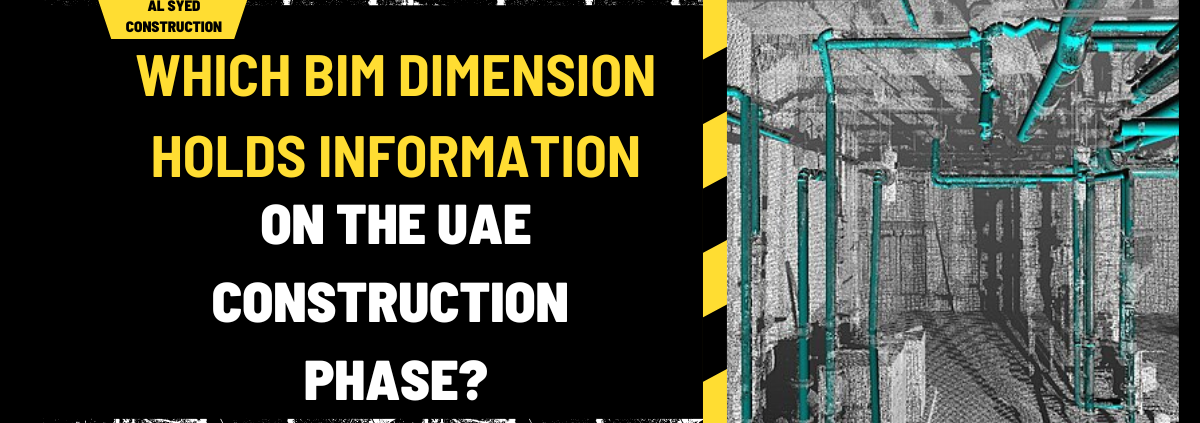Which BIM Dimension Holds Information on the UAE Construction Phase?
In the realm of Building Information Modeling (BIM), understanding the various dimensions is crucial for effectively managing the construction process. BIM dimensions provide different layers of information that enhance the efficiency and effectiveness of construction projects. This article will focus on identifying and exploring the BIM dimension that specifically holds information on the construction phase.
Introduction to BIM Dimensions
BIM dimensions represent various aspects of a building’s lifecycle, offering comprehensive data from design to construction and beyond. Each dimension in BIM provides unique information crucial for different stages of a project. The primary BIM dimensions include:
- 2D: Traditional drawings and plans.
- 3D: Spatial and geometric data.
- 4D: Time-related information.
- 5D: Cost-related data.
- 6D: Sustainability and energy performance.
- 7D: Facility management and operations.
Understanding the Construction Phase in BIM
The construction phase of a project involves the physical building activities that bring design plans to reality. It includes the scheduling, management of resources, and execution of construction tasks. To effectively manage and streamline the construction phase, BIM provides specific dimensions that incorporate time-related data and construction scheduling.
The Role of 4D BIM in the Construction Phase
The BIM dimension that specifically holds information on the construction phase is 4D BIM. Here’s a detailed look at how 4D BIM functions and its significance in construction:
1. Definition of 4D BIM
4D BIM integrates 3D model data with time-related information to create a time-based simulation of the construction process. It allows project stakeholders to visualize the construction sequence and track the progress of the building process over time.
2. Scheduling and Sequencing
Scheduling and sequencing are fundamental components of 4D BIM. This dimension links the 3D model of the building with the project timeline. By doing so, it enables stakeholders to:
- Visualize Construction Phases: See how the construction progresses over time with a visual representation of the building coming together.
- Identify Critical Path: Determine which activities are critical to project completion and need to be prioritized.
- Optimize Scheduling: Adjust schedules based on visual simulations to avoid conflicts and optimize workflow.
3. Resource Management
Effective resource management is facilitated by 4D BIM through the integration of time and spatial data. It helps in:
- Allocating Resources Efficiently: Assigning equipment, materials, and labor to specific construction phases based on the timeline.
- Preventing Resource Overlaps: Identifying and resolving potential overlaps or shortages of resources before they affect the project.
4. Communication and Coordination
4D BIM enhances communication and coordination among various stakeholders by:
- Providing Clear Visualizations: Offering a clear view of construction progress to all team members, which aids in better understanding and coordination.
- Facilitating Collaboration: Enabling real-time updates and adjustments to the construction plan based on ongoing feedback and observations.
5. Risk Management
Risk management is a key benefit of 4D BIM, as it allows:
- Early Identification of Risks: Spotting potential delays or conflicts in the construction schedule and addressing them proactively.
- Simulating Scenarios: Testing various scenarios to understand the impact of potential issues and adjusting plans accordingly.
6. Enhancing Project Efficiency
By integrating construction activities with the 3D model, 4D BIM contributes to overall project efficiency by:
- Reducing Errors: Minimizing the likelihood of errors through accurate visual and time-based simulations.
- Streamlining Processes: Ensuring that construction processes are well-organized and executed in the most efficient manner.
Examples of 4D BIM in Action
To illustrate the effectiveness of 4D BIM, here are a few examples:
- Construction of High-Rise Buildings: 4D BIM is used to plan and visualize the sequential assembly of high-rise structures, ensuring that all trades and tasks are coordinated effectively.
- Infrastructure Projects: For complex infrastructure projects such as bridges and tunnels, 4D BIM helps manage intricate scheduling and resource requirements.
Challenges and Considerations with 4D BIM
While 4D BIM offers numerous benefits, it also comes with challenges, including:
1. Data Integration
Integrating time-based data with 3D models can be complex and requires accurate input to ensure that the simulations reflect real-world scenarios.
2. Software and Technology Requirements
4D BIM requires advanced software and technology capable of handling complex simulations and real-time updates, which may involve significant investment.
3. Training and Expertise
Effective use of 4D BIM demands skilled personnel who are trained in both BIM software and project management techniques.
Conclusion
The 4D BIM dimension is pivotal in managing the construction phase of a project. By integrating time-related data with spatial models, it enhances scheduling, resource management, and communication, ultimately contributing to the success of the construction process. As the construction industry continues to evolve, leveraging 4D BIM will become increasingly important for achieving project goals efficiently and effectively.




